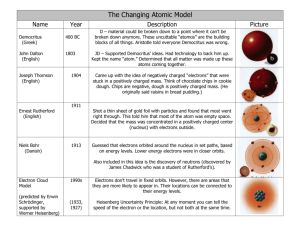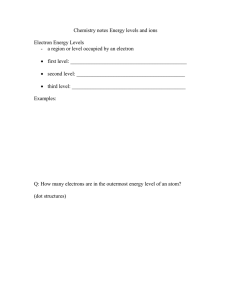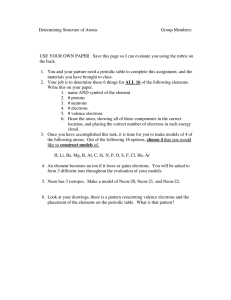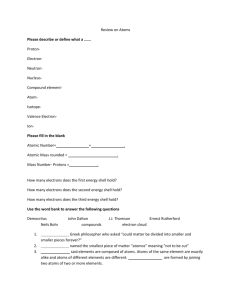11 Self-Quiz
advertisement
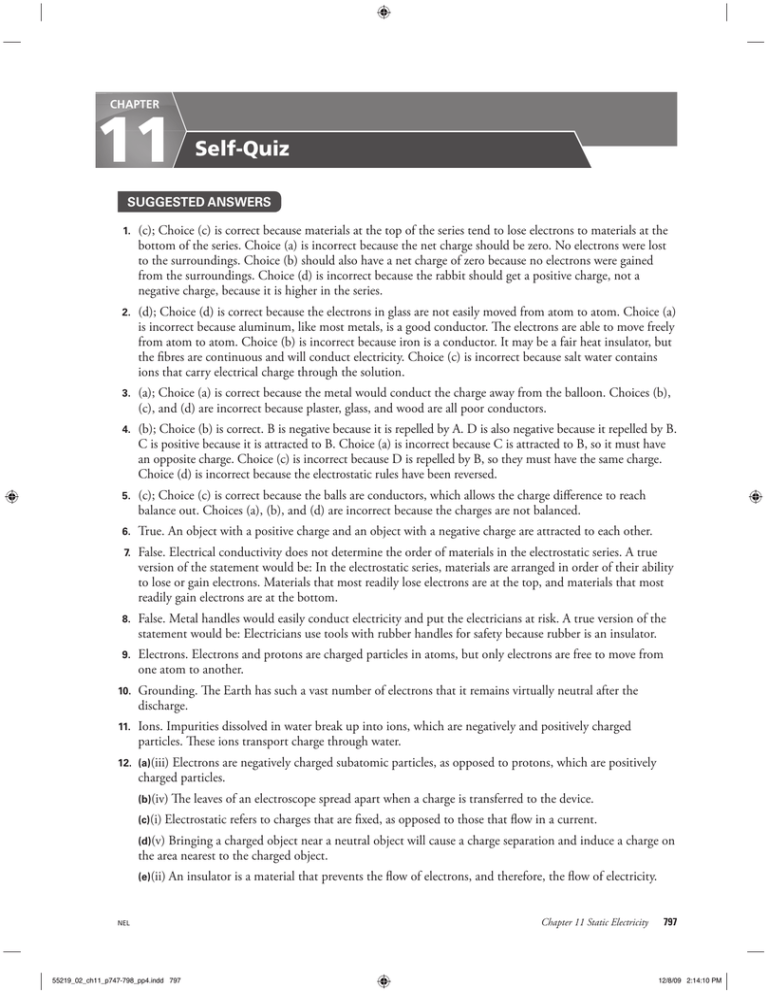
CHAPTER 11 Self-Quiz SUGGESTED ANSWERS 1. (c); Choice (c) is correct because materials at the top of the series tend to lose electrons to materials at the bottom of the series. Choice (a) is incorrect because the net charge should be zero. No electrons were lost to the surroundings. Choice (b) should also have a net charge of zero because no electrons were gained from the surroundings. Choice (d) is incorrect because the rabbit should get a positive charge, not a negative charge, because it is higher in the series. 2. (d); Choice (d) is correct because the electrons in glass are not easily moved from atom to atom. Choice (a) is incorrect because aluminum, like most metals, is a good conductor. The electrons are able to move freely from atom to atom. Choice (b) is incorrect because iron is a conductor. It may be a fair heat insulator, but the fibres are continuous and will conduct electricity. Choice (c) is incorrect because salt water contains ions that carry electrical charge through the solution. 3. (a); Choice (a) is correct because the metal would conduct the charge away from the balloon. Choices (b), (c), and (d) are incorrect because plaster, glass, and wood are all poor conductors. 4. (b); Choice (b) is correct. B is negative because it is repelled by A. D is also negative because it repelled by B. C is positive because it is attracted to B. Choice (a) is incorrect because C is attracted to B, so it must have an opposite charge. Choice (c) is incorrect because D is repelled by B, so they must have the same charge. Choice (d) is incorrect because the electrostatic rules have been reversed. 5. (c); Choice (c) is correct because the balls are conductors, which allows the charge difference to reach balance out. Choices (a), (b), and (d) are incorrect because the charges are not balanced. 6. True. An object with a positive charge and an object with a negative charge are attracted to each other. 7. False. Electrical conductivity does not determine the order of materials in the electrostatic series. A true version of the statement would be: In the electrostatic series, materials are arranged in order of their ability to lose or gain electrons. Materials that most readily lose electrons are at the top, and materials that most readily gain electrons are at the bottom. 8. False. Metal handles would easily conduct electricity and put the electricians at risk. A true version of the statement would be: Electricians use tools with rubber handles for safety because rubber is an insulator. 9. Electrons. Electrons and protons are charged particles in atoms, but only electrons are free to move from one atom to another. 10. Grounding. The Earth has such a vast number of electrons that it remains virtually neutral after the discharge. 11. Ions. Impurities dissolved in water break up into ions, which are negatively and positively charged particles. These ions transport charge through water. 12. (a)(iii) Electrons are negatively charged subatomic particles, as opposed to protons, which are positively charged particles. (b)(iv) The leaves of an electroscope spread apart when a charge is transferred to the device. (c)(i) Electrostatic refers to charges that are fixed, as opposed to those that flow in a current. (d)(v) Bringing a charged object near a neutral object will cause a charge separation and induce a charge on the area nearest to the charged object. (e)(ii) An NEL 55219_02_ch11_p747-798_pp4.indd 797 insulator is a material that prevents the flow of electrons, and therefore, the flow of electricity. Chapter 11 Static Electricity 797 12/8/09 2:14:10 PM 13. Electrons are transferred from the outer shells of the atoms of one material to those of another material. 14. Rubber and plastic insulate the wire and protect people from the current flowing through the wire. 15. (a) The rods should be positioned along the highest parts of the barn roof so that lightning strikes them first instead of the barn. (b) The rods would need to be connected to the ground by conductive wires so that the charge from the lightning will be grounded. 16. Sample answer: I would wear gloves and high boots made of rubber or other electrically insulating material. The rubber would insulate me from electrical currents that pass from the broken line and then through the rainwater. 17. (a) (b) Put a charge on an insulating material, such as a rubber rod, and touch it to the ball of the electroscope. If the charge is transferred successfully, the leaves will spread apart. Touch an object made of conducting material to the ball. If the charge is successfully removed, the leaves will fall together. 18. ⫹ ⫹ ⫺ ⫹ ⫹ ⫺ ⫹⫹ ⫹ ⫹ ⫺ ⫺ ⫹ ⫹ ⫺ ⫺ ⫺ ⫹ ⫺ ⫺ ⫺ ⫺⫺ ⫺ ⫺ ⫹ ⫹ ⫺ ⫺⫺ 19. ⫺ ⫹ 20. (a) (b) ⫺ ⫹ ⫹ ⫹ ⫺ ⫹ ⫹ ⫹ ⫺ Electrons were transferred from the outer shells of atoms in the glass to the atoms in the tape. The tape becomes negatively charged because some of its atoms now have more electrons than protons. Some of the atoms in the glass lost electrons from their outer shells, leaving them with more protons than electrons. As a result, the glass becomes positively charged. 21. Clothes are made of different fabrics that occupy different positions in the electrostatic series. As a result, atoms in some clothes gain electrons and atoms in other clothes lose electrons as they rub together. When the clothes come out of the dryer, the positively charged clothes are attracted to the negatively charged ones. 22. Sample answer: First, rub a piece of vinyl against a piece of glass, so that the vinyl becomes negatively charged and the glass becomes positively charged. Then, rub another piece of glass with cat fur. Test to see if that piece of glass is attracted to the positively charged glass and repelled by the negatively charged vinyl; if so, then cat fur is above vinyl and below glass. Finally, rub a third piece of glass with hard rubber. Test to see if that piece of glass is attracted to the positively charged glass; if so, then hard rubber is above vinyl as well. 23. The contact between the truck tires and the ground can cause an electrostatic charge to build up on the truck. If the truck suddenly discharged, the flammable material could ignite. The chain grounds the truck and prevents an electrostatic charge from building up on the truck. 798 Unit E: The Characteristics of Electricity 55219_02_ch11_p747-798_pp4.indd 798 NEL 12/8/09 2:14:10 PM
